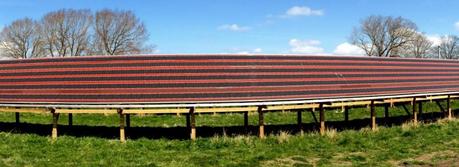 DTU's solar park with polymer solar cells installed. (Credit: DTU Energy Conversion / plasticphotovoltaics.org)
DTU's solar park with polymer solar cells installed. (Credit: DTU Energy Conversion / plasticphotovoltaics.org)Project Megawatt intends to make polymer solar cells profitable enough to allow power generation from polymer solar cells to compete on market terms with traditional coal-fired power plants.
Advanced market models and a 1000 m2 (10764 ft2) test facility at DTU Risø Campus at Technical University of Denmark’s Department of Energy Conversion and Storage might lift the curse of spot prices from renewable energy.
Spot pricing is the price of electricity sold on the commercial market via day-ahead and intraday trading, but invented to allow customers to buy the cheapest energy possible, it is a curse on renewable energy.
As an example; energy from wind turbines and solar cells breaks just about even if the energy generated is sold at approx. 0.40 DKK/kW·h ($0.19) plus subsidies, but due to an abundance of energy on windy and/or sunny days, the renewable energy is often sold at or near the lowest price of 0.25 DKK/kW·h ($0.05), forcing the government to step in with even more subsidies. (See this article for solar energy prices in the U.S.)
“Spot prices on electricity is lethal to most business models involving renewable energy,” says Professor Frederik C. Krebs, Department of Energy Conversion and Storage, one of Europe’s leading researchers in polymer solar cells and initiator of the project Polymer solar cells in megawatt scale, called Megawatt.
Polymer solar cells made of organic materials instead of silicon is a new and promising technology. It is inexpensive to make and quick to set up, and project Megawatt aims to make polymer solar cells totally independent of public subsidies and allow the energy from polymer solar cells to be sold at 0.25 DKK/kWh.
“It’s all about demonstrating polymer solar cells as a sustainable, reliable, fully scalable and especially cost-effective energy conversion technology,” says Professor Frederik C. Krebs.
Preliminary studies show that a polymer solar park needs to provide between 100 megawatt and up to 1 gigawatt before producing enough power to tolerate a bargain price of 0.25 DKK/kWh.
“I think 100-200 megawatts will do it, but it requires a lot of square kilometers, if I should prove it. Instead we test the area effect in a smaller test facility. Which will also allow us to test the need for storage, that is how long time we need to be able to store the energy, before it becomes profitable at a given production capacity,” says Frederik C. Krebs.
The Department for Energy Conversion and Storage is to create and test the solar cell technology, while the partners Gaia Solar and EnergyMidt are responsible for installation, operation and market analysis.
Gaia Solar, one of the leading suppliers of complete photovoltaic systems in Scandinavia, is expert in setting up solar power plants cheap and efficiently but inexperienced in polymer solar cells. Traditional Silicon solar cells are expensive to set up, but once up they are robust and require almost no upkeep; polymer solar cells are cheap to set up but require more maintenance, hence Gaia Solar has to redo and test all the procedures before calculating the real cost of installation and operation.
These results will be included in the final cost-benefit analysis made by the major Danish energy supplier EnergiMidt, who will be using advanced market analysis models to evaluate the performance per square meter of polymer solar cells and put it up against the spot prices, and thus determine the need for energy storage if polymer solar cells are to be profitable.
“Our goal is to be able to store the energy for a whole day, but in the process we’ll evaluate the benefits of storing the energy for six or maybe just three hours until nightfall, when the need for energy and thus the spot prices rise, making the renewable energy profitable,” says Frederik C. Krebs.
Project Megawatt started 1 April 2014 and is expected to be finished by 2017. It is funded by energinet.dk via the PSO-grant ForskEL.

